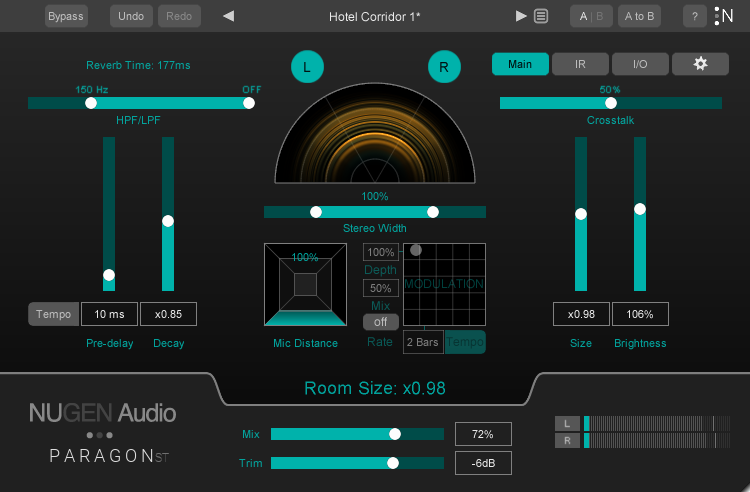Information accurate at the time of publishing - last edited 18 October 2021
Paragon ST is a stereo-only version of Paragon, NUGEN Audio’s true convolution reverb, now enhanced for music production and stereo processing. This release comes with a handful of new features and controls, including stereo width, reverb modulation, mic distance, and the ability to lock pre-delay to the project tempo.
If you’re making house music, trip hop, or countless other electronic subgenres, reverb is a powerful tool for adding depth to a mix. The realism and authenticity of Paragon ST’s reverb models can be great for breathing life into synthetic or programmed elements. Even still, out of control reverb can cause your mix to get swamped.
Whether you’re using Paragon ST, or a different reverb plug-in, here are 5 tips for tightening up your mix.
Shorten the decay time
Shortening your reverb decay time is a quick-and-easy method to avoid overwhelming a mix. For beat-orientated music with a lot of transients, a general rule of thumb is that the reverb tail should drop off before the next hit. This allows more headroom, which means more impact.
Paragon ST has the ability to alter decay time individually per channel. You can find this in the I/O panel. If the left and right channels sound too similar, this can cause your mix to collapse towards mono, giving the impression of a narrower stereo image. By applying similar - but not identical - reverb processing to each channel, you can prevent the mix from losing its stereo width.

Add reverb to a delay send
If an element in your mix has been sent to a delay effect, you might find that the delay repeats are too prominent. If you don’t want to adjust the volume of the FX return, you can add reverb to the delayed signal in order to place it “further back” in the mix. By adding Paragon ST as an insert on the FX send, you can apply reverb only to the wet delay signal.
Be cautious, and use subtlety in your reverb parameters; ideally you only want a small amount of reverb decay to glue the mix together, too much and unwanted muddiness can creep in very quickly.
Increase the pre-delay
Most reverb plug-ins will have a pre-delay control. This determines the time difference between the original audio and the start of the reverb signal. A small amount of pre-delay gives the dry audio some breathing space before the first reverb reflection, which can significantly tidy up a mix. If the overall decay time is short, then a shorter pre-delay will sound more natural. For example, a “small room” style reverb might work well with 0-10 milliseconds of pre-delay.
In Paragon ST, the pre-delay can be synchronised with the tempo of the track. With this control activated, the pre-delay time will be displayed in musical note values rather than milliseconds. Back on the I/O panel, the pre-delay for each channel can be tweaked individually. This could be another way to create a wider stereo image.
Gated reverb
Gated reverb is often associated with the 80’s - check out Phil Collins, especially the iconic drum fill from ‘In The Air Tonight’. Similar to shortening the reverb decay time, gated reverb is another way to create space between transients. This effect is mostly used for drums and percussion, but can also be applied to other elements like vocals, in order to give your track a retro aesthetic.
In order to set up a gated reverb, you should place a noise gate on the FX send after your reverb plug-in. Set your threshold so the gate opens when the first reverb reflections start. Try lowering the threshold or experimenting with the release time in order to make the reverb signal cut off just before the next big transient.
Add side-chain compression to reverb
Side-chain compression is a common effect used in electronic music, typically as a “ducking” effect on melodic elements to make room for the drums. ‘Teardrop’ by Massive Attack is a great example of how this allows the transients to cut through.
To set this up, insert a compressor with side-chain capabilities on the FX send after your reverb plug-in. Choose which element you want to trigger the side-chain - most likely a kick drum, snare drum or both - and set this as the side-chain source.
Applying side-chain compression to a reverb send is a powerful way to create space, reigning in long, cavernous reverbs and delays.
If you'd like to try out these tips yourself, Paragon ST is available for a free 15-day trial.
More like this
Share this